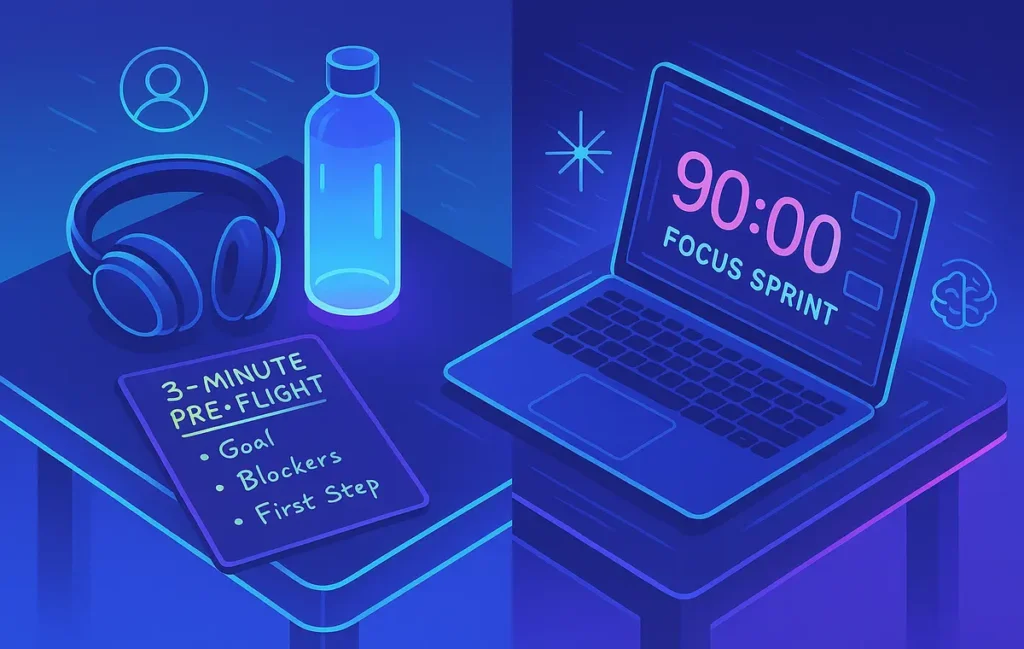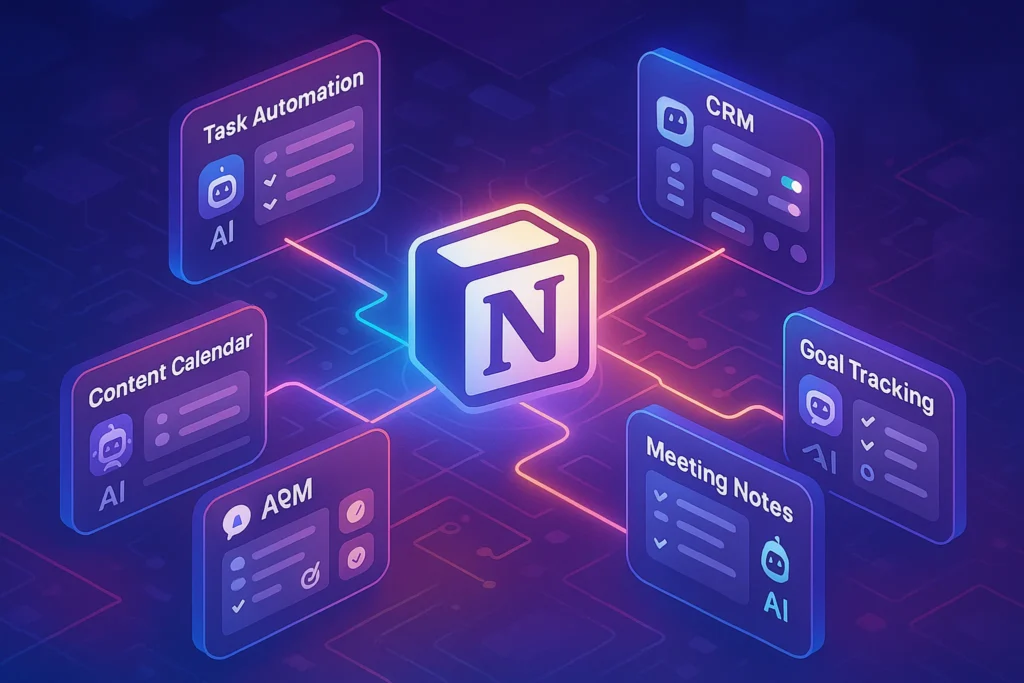🎣 Intro: Deep Work Is Not an Event—It’s a System
“Deep work” gets romanticized as a magical flow state that appears when the stars align: a free afternoon, a perfect mood, zero notifications. That mythology is the problem. If focus depends on luck, your output will too. In reality, deep work is a behavioral system—a stack of small, repeatable decisions that make high-quality concentration the default. The good news: systems are buildable. With the right cues, environment, and rewards, you can train your brain to return to depth every day, on schedule.
If you need a refresher on definitions, begin with Deep Work 101 for the conceptual foundations. But this guide is deliberately practical. We’ll translate habit theory into rituals you can run tomorrow, then scale into a sustainable weekly cadence. Along the way, we’ll connect to complementary tactics in Pro Tips for Boosting Focus in a Distracted World and a pragmatic comparison in Time Blocking vs. Pomodoro—because your calendar is the bedrock of repeatable focus.
💡 Nerd Tip: Replace “I will focus more” with “Every weekday at 9:00–11:00, I run my Focus Sprint Ritual.” Vague goals don’t stand a chance against clear systems.
🎯 Step 1 — Define Your Deep Work Goals (Make Output Measurable)
You can’t build a habit around a vague aspiration. The brain needs a concrete target and a quick feedback loop. Start by translating ambitions into visible outputs and weekly quotas. A writer’s goal isn’t “write more”; it’s “finish two 1,200-word sections by Friday.” A developer’s isn’t “learn Rust”; it’s “ship a working CLI parser and write tests by Sprint 2.” Designers might commit to “finalize 10 mobile screens with annotations by Thursday stand-up.” Pick 1–3 outputs that create momentum and make those the anchor for your deep work blocks.
Tie each output to a lead metric you can move today (words, design hours, test cases written) and a lag metric that reflects results (published posts, shipped features, accepted designs). During each deep work session, track the lead metric only. The lag metric is reviewed weekly. This split matters: you want to reward the controllable behavior now and evaluate the outcomes later. If you’re just getting started, define a minimum viable quota—say, 60 minutes of deep work per weekday—and expand only when your consistency hits 80% or more across two weeks.
It also helps to decide what deep work is not. That means explicitly listing common traps: Slack replies, inbox sorting, light refactors, tinkering with fonts, changing color tokens, or “research” that’s really link-surfing. Parking these in a “shallow work parking lot” keeps your session clean. If you want a fuller decision tree for what counts, skim Mastering Focus in the Age of Digital Distractions and adopt its yes/no rubric.
💡 Nerd Tip: Your first win is consistency, not volume. A reliable daily 60 minutes beats a heroic but sporadic 4-hour sprint that wipes you out.
🕯️ Step 2 — Build Rituals & Triggers (The 3-Minute Pre-Flight)
Habits crystallize around a cue → routine → reward loop. Your job is to engineer that loop so entering depth becomes automatic. The simplest way is a “3-minute pre-flight” ritual you run at the same time and place each day:
-
Cue: Brew a coffee or tea, put on instrumental focus music, and physically clear your desk. Put your phone in a drawer or across the room.
-
Routine: Open your “Focus Deck” (a single document that holds today’s micro-plan), set a 90-minute timer, and close everything else.
-
Reward: Promise yourself a small, reliable payoff after the session: a walk, snack, or checking a favorite feed for five minutes only.
The magic isn’t the coffee; it’s consistency. When your brain sees the same sequence in the same order, it learns that “this is the part where we go deep.” To reinforce the association, start with manageable intensity. If you’re rusty, begin with 50–60 minutes (two extended Pomodoros) and scale to 90–120 minutes once you’re hitting your targets. End every session with a one-minute “shutdown sentence”: “Today I completed X; next step tomorrow is Y.” That simple line reduces cognitive residue and makes the next start easier.
Rituals thrive on place as much as time. If you can, designate a physical zone for deep work—another chair, another desk, even a specific corner at a café. Spatial cues reduce the decision energy required to start. If you must go portable, carry a lightweight “focus kit”: noise-blocking earbuds, a paper notecard with your pre-flight checklist, and a device stand that signals “we’re working now.”
💡 Nerd Tip: Never negotiate with a timer mid-session. If a thought pops up, capture it in a quick scratchpad and return to the task. Your scratchpad is the pressure valve that protects depth.
📅 Step 3 — Structure Your Time (Blocks, Sprints, and Recovery)
Time structure turns rituals into a calendar reality. Two methods dominate: time blocking (pre-allocate calendar blocks to key tasks) and Pomodoro-style sprints (work in timed intervals with short breaks). Each has trade-offs. Time blocking excels at defending large, uninterrupted windows. Pomodoro shines when attention is skittish or tasks are less predictable. Many high performers mix them: block a 2-hour window and run 2×50/10 sprints inside it.
If you haven’t chosen a system, our guide Time Blocking vs. Pomodoro shows when each wins. For a deeper tooling layer, curate your app stack with Best Pomodoro Apps That Actually Improve Focus & Deep Work—but don’t over-optimize. The calendar, not the app, is the habit. A few practical notes:
-
Duration: Most people peak at 90–120 minutes for cognitively demanding tasks. Longer sessions suffer diminishing returns unless you train up slowly.
-
Breaks: 5–10 minutes between sprints are fine, but don’t open inboxes or social feeds. Do a micro-walk, stretch, or breathe.
-
Placement: Anchor your prime block when your energy is highest (often morning). If the world keeps stealing your mornings, flip it: run a protected “last two hours” block when interruptions fall.
-
Recovery: Protect a 15–20 minute buffer after deep work for admin tasks. Without a gentle on-ramp, shallow work will invade your block from the edges.
Mini Comparison Table
| Method | Best For | Strength | Watch-Out |
|---|---|---|---|
| Time Blocking | Big deliverables, predictable days | Defends large windows | Needs calendar discipline |
| Pomodoro 50/10 | Warming up, variable tasks | Easy momentum | Breaks can derail if you open inbox |
| Focus Sprints (90–120) | High-stakes creative/code | Deep throughput | Requires pre-planned breaks |
💡 Nerd Tip: Schedule your most fragile block first—then let less critical meetings fall around it. If it isn’t on the calendar, it isn’t a habit.
🧹 Step 4 — Environment & Digital Hygiene (Design for Zero Friction)
Willpower is a poor firewall. Environment design wins because it removes decisions. Start by building a focus mode that toggles in one click: Do Not Disturb on your computer and phone, status auto-replies in Slack/Teams, and calendar visibility set to “Busy—Focus.” Route only true emergencies through a single channel (one person who can call twice to break through). Use a single-purpose browser profile for deep work with no social bookmarks and only the tabs you need. If research is part of your session, batch it: write in your editor; collect tabs in a read-later queue; review them after the session ends.
Take distractions seriously as context switchers, not minor annoyances. Every interruption steals minutes in re-immersion. If you want tactics, borrow from Pro Tips for Boosting Focus in a Distracted World: disable badges, strip your dock/taskbar to essentials, and hide the menu bar clock during sprints to avoid time anxiety. For device discipline, consider the “two-device mode”: work laptop for creation, phone in airplane mode. If you must keep the phone reachable, park it face down behind you, not beside the keyboard. Physical separation matters.
Finally, clean the cognitive hallway. Before you start, run a 60-second inbox triage: move everything to a holding label (“Later Today”) except genuine fires. Then close email. If you can’t resist peeking, install a blocker during your block (e.g., Screen Time, Focus, Freedom). This isn’t asceticism; it’s ergonomics for attention.
💡 Nerd Tip: Set a 3-item “Session Menu” on a sticky note. If you complete the first, you move directly to the second—no re-planning mid-flow.
🎁 Step 5 — Rewards & Reinforcement (Make Consistency Feel Good)
Habits stabilize when your brain expects a reliable reward. Keep it simple and sustainable. A walk, a favorite song, or a 5-minute social check are enough when they’re tied immediately to session completion. Layer in streak tracking (a small grid you mark daily) and a Success Jar—write one win on a slip of paper after each session and drop it in. On Fridays, read a few. It sounds quaint, but it’s powerful: your brain gets visual evidence that the system works.
Weekly, run a 15-minute review. Log total deep work minutes, outputs shipped, and one friction you’ll remove next week. If you’re not hitting 80% of scheduled sessions, reduce scope. Shrink the window, cut the task size, or move the time to a friendlier slot. Celebrate tiny wins aggressively. The point isn’t perfection; it’s making progress feel inevitable.
Social reinforcement helps too. Inform your team (or household) about your focus windows and create a “Do Not Disturb” signal—a desk light, a sign, or a status emoji. Guardrails plus accountability beat white-knuckle discipline. If your organization keeps breaking your blocks with meetings, borrow policies from Pro Tips for Boosting Focus in a Distracted World—meeting-free mornings or “No-Meeting Wednesdays”—and measure the results.
💡 Nerd Tip: Don’t chain punishments to missed sessions. Reset quickly with the tiniest possible win (10 focused minutes). Protect the identity—“I’m a person who does deep work daily”—over any single performance.
⏱️ Stop Hoping for Focus. Systematize It.
Build your daily Focus Sprint with time-blocking templates and distraction blockers. Start small, stack wins, and make deep work your default.
📈 The 30-Day Deep Work Habit Plan (Checklist You Can Copy)
Week 1—Install the System:
-
Choose one daily 60-minute block (same time/place).
-
Write your 3-minute pre-flight on a card.
-
Create a single-purpose browser profile + enable system-wide Focus mode.
-
Define one output metric (e.g., words written) and log it daily.
Week 2—Stabilize & Stretch:
-
Extend to 75–90 minutes when you hit 4/5 days.
-
Add a one-minute shutdown sentence to end each session.
-
Introduce a small reward (walk, snack, song) right after.
-
Share your schedule with a teammate or family member.
Week 3—Stack a Second Block:
-
Add a second 45–60 minute block 2–3 times this week.
-
Batch shallow work into a 30-minute admin window post-session.
-
Remove one friction (e.g., hide the dock or move the phone).
Week 4—Review & Personalize:
-
Hit 5 days of deep work with at least 6 total hours.
-
Run a 15-minute weekly review: log totals, wins, friction.
-
Decide next month’s target: +1 hour/week or +1 session.
Math that motivates:
Even 30 minutes/day × 5 days × 48 working weeks = 120 hours/year (15 workdays).
A mature practice of 10 hours/week × 48 weeks = 480 hours/year = 60 workdays (~12 full work weeks) of deep output.
🧪 Real-World Patterns: What Actually Moves the Needle
A few patterns show up again and again when people move from “aspiring” to “consistent”:
Smaller starts win. Ambitious schedules collapse under real life. The folks who start with 45–60 minutes and add 15 minutes every two weeks keep their streaks alive. Momentum beats intensity.
Context walls are priceless. The biggest leap often comes from a single rule: no meetings in the first two hours, ever. Protect one clean morning block and your weekly output jumps without changing anything else.
Ritual identity sticks. People who give their practice a name—“Daily Sprint,” “Quiet Hour,” “Monk Mode 9–11”—stick with it longer. Names create identity; identity creates persistence.
Tools are multipliers, not saviors. Better apps won’t fix a chaotic calendar. But once your blocks exist, the right timer or blocker can add 10–20% more usable focus. When you’re ready to upgrade tooling, choose from Best Pomodoro Apps That Actually Improve Focus & Deep Work.
💡 Nerd Tip: If you’re plateauing, change just one variable for 7 days: time of day, location, or session length. Then evaluate with your weekly review.
🧱 Common Pitfalls & How to Fix Them
Starting too big. You schedule two 2-hour blocks daily, miss twice, and the identity collapses. Fix: scale to a daily 45–60 minutes, rebuild trust, then expand.
Letting “research” devour creation. The internet loves to masquerade as work. Fix: separate discovery (afternoons) from production (mornings). During deep work, write first, research later.
Fragile environment. Open offices, noisy flats, school runs—life happens. Fix: noise-blocking earbuds, a portable focus kit, and explicit family/roommate agreements for your focus windows.
Calendar whiplash. Meetings invade because there’s no policy. Fix: block your focus windows as recurring “Busy—Focus” events; encourage teammates to check Mastering Focus in the Age of Digital Distractions for norms that reduce interruption culture.
All reward, no reflection. You celebrate but don’t learn. Fix: keep a one-page “friction log” and remove one obstacle per week. Compounding small fixes wins the month.
👥 Personas: Build Your Habit Like You
Student: Anchor one 90-minute block before lunch for concept-heavy subjects. Use evenings for revision and flashcards. Keep the phone in another room; your dorm is not a focus sanctuary by default.
Software Engineer: Put deep work before stand-ups if you can (8:00–9:30). Use code review and Slack after lunch. Batch PR feedback in a single 45-minute block to avoid death by pings.
Designer/Creator: Protect morning concept work (sketching, layout, storyboards). Client communication and asset export happen later. The XDR/Retina panel is seductive—hide Figma community and Dribbble during sprints.
Founder/Manager: You’ll never “find time.” Declare two non-negotiable 90-minute slots weekly for strategic writing (memos, hiring scorecards, positioning). Management is shallow by default; leadership requires depth.
💡 Nerd Tip: Build one universal cue across all personas (same playlist, same mug) so your brain recognizes “we’re in.”
📬 Want More Smart AI Tips Like This?
Join our free newsletter and get weekly insights on AI tools, no-code apps, and future tech—delivered straight to your inbox. No fluff. Just high-quality content for creators, founders, and future builders.
🔐 100% privacy. No noise. Just value-packed content tips from NerdChips.
🧠 Nerd Verdict
Deep work is not a personality trait. It’s engineered through small, boringly consistent decisions: a fixed cue, a defended time, an environment that removes choices, and a reward that closes the loop. When you treat focus as a daily practice—rather than a rare, romantic event—you regain control of your calendar and your craft. Build the system once; let it pay you back every day.
❓ FAQ: Nerds Ask, We Answer
💬 Would You Bite?
If you had to pick one ritual to start tomorrow—same playlist, a 3-minute pre-flight, or a locked 9–10 a.m. block—which would you choose?
Share your pick and your role; NerdChips will help you tune it for your week. 👇
Crafted by NerdChips for creators and teams who want their best ideas to travel the world.



